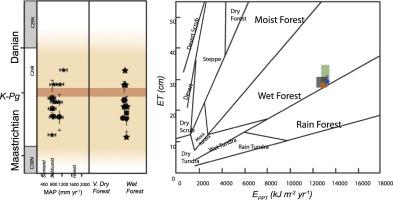当前位置:
X-MOL 学术
›
Gondwana Res.
›
论文详情
Our official English website, www.x-mol.net, welcomes your feedback! (Note: you will need to create a separate account there.)
Stable climate in India during Deccan volcanism suggests limited influence on K–Pg extinction
Gondwana Research ( IF 6.1 ) Pub Date : 2020-09-01 , DOI: 10.1016/j.gr.2020.04.007 R.M. Dzombak , N.D. Sheldon , D.M. Mohabey , B. Samant
Gondwana Research ( IF 6.1 ) Pub Date : 2020-09-01 , DOI: 10.1016/j.gr.2020.04.007 R.M. Dzombak , N.D. Sheldon , D.M. Mohabey , B. Samant

|
Abstract Large igneous provinces (LIPs) have been temporally correlated to mass extinctions throughout the Phanerozoic, including the emplacement of the Deccan Volcanic Province (DVP; 66.3–65.6 Ma) in western and central India, which has been invoked as either a cause or exacerbating factor in the Cretaceous-Paleogene (K-Pg) extinction. However, relatively little is known about local paleoclimatic and paleoenvironmental responses to volcanism. To investigate the DVP's role as a driver of local environmental change and to provide climatic background for known ecological shifts, new inter-basaltic paleosol profiles at the eastern edge of the DVP are used in conjunction with profiles from the literature to reconstruct paleoclimate and terrestrial environments before and after the K–Pg. These profiles provide a novel opportunity to study the sediments within basalt flows before, during, and after a mass extinction event and in the midst of a LIP emplacement event. Paleoclimate proxies and the Floral Humidity Province proxy reflect little long-term change in either climate or environment across the K–Pg, with stable precipitation values and temperatures accompanied by a constant forest signal. These interpretations are corroborated by macrofloral records and sedimentology from India, which suggest some environmental turnover but generally support a forested, fluvio-lacustrine environment throughout the duration of volcanism. Our results support the possibility of rapid recovery times for terrestrial ecosystems during volcanism and suggest that while DVP eruptions may have exacerbated long-term environmental perturbation, the emplacement of the DVP is not likely to have caused the terrestrial mass extinction at the K–Pg boundary.
中文翻译:

德干火山活动期间印度的稳定气候表明对 K-Pg 灭绝的影响有限
摘要 大型火成岩省 (LIPs) 在时间上与整个显生宙的大规模灭绝有关,包括在印度西部和中部的德干火山省 (DVP; 66.3-65.6 Ma) 的就位,这被认为是原因或加剧白垩纪-古近纪 (K-Pg) 灭绝的因素。然而,人们对当地古气候和古环境对火山活动的反应知之甚少。为了研究 DVP 作为当地环境变化驱动因素的作用并为已知的生态变化提供气候背景,DVP 东部边缘的新玄武岩间古土壤剖面与文献中的剖面结合使用,以重建古气候和陆地环境K-Pg 之前和之后。这些剖面为研究大灭绝事件之前、期间和之后以及 LIP 就位事件期间玄武岩流中的沉积物提供了新的机会。古气候代理和花卉湿度省代理反映了 K-Pg 气候或环境的长期变化很小,降水值和温度稳定,伴随着恒定的森林信号。这些解释得到了来自印度的宏观植物记录和沉积学的证实,这表明环境发生了一些变化,但在整个火山活动期间通常支持森林覆盖的河流湖泊环境。我们的结果支持火山活动期间陆地生态系统快速恢复时间的可能性,并表明虽然 DVP 喷发可能加剧了长期的环境扰动,
更新日期:2020-09-01
中文翻译:

德干火山活动期间印度的稳定气候表明对 K-Pg 灭绝的影响有限
摘要 大型火成岩省 (LIPs) 在时间上与整个显生宙的大规模灭绝有关,包括在印度西部和中部的德干火山省 (DVP; 66.3-65.6 Ma) 的就位,这被认为是原因或加剧白垩纪-古近纪 (K-Pg) 灭绝的因素。然而,人们对当地古气候和古环境对火山活动的反应知之甚少。为了研究 DVP 作为当地环境变化驱动因素的作用并为已知的生态变化提供气候背景,DVP 东部边缘的新玄武岩间古土壤剖面与文献中的剖面结合使用,以重建古气候和陆地环境K-Pg 之前和之后。这些剖面为研究大灭绝事件之前、期间和之后以及 LIP 就位事件期间玄武岩流中的沉积物提供了新的机会。古气候代理和花卉湿度省代理反映了 K-Pg 气候或环境的长期变化很小,降水值和温度稳定,伴随着恒定的森林信号。这些解释得到了来自印度的宏观植物记录和沉积学的证实,这表明环境发生了一些变化,但在整个火山活动期间通常支持森林覆盖的河流湖泊环境。我们的结果支持火山活动期间陆地生态系统快速恢复时间的可能性,并表明虽然 DVP 喷发可能加剧了长期的环境扰动,



























 京公网安备 11010802027423号
京公网安备 11010802027423号